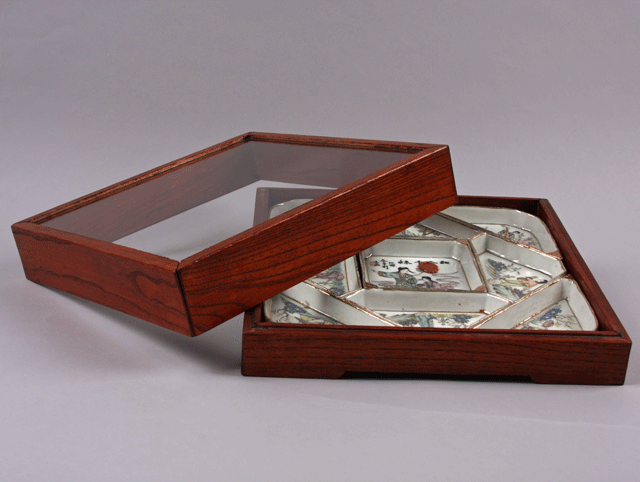
Wood and porcelain tray owned by the Chan Family. For a second photo of the tray,
please click here. Photo by T. Ocken.

Wood and porcelain tray owned by the Chan Family. For a second photo
of the tray,
please click
here. Photo by T. Ocken.
Ms. Carolyn Chan writes:
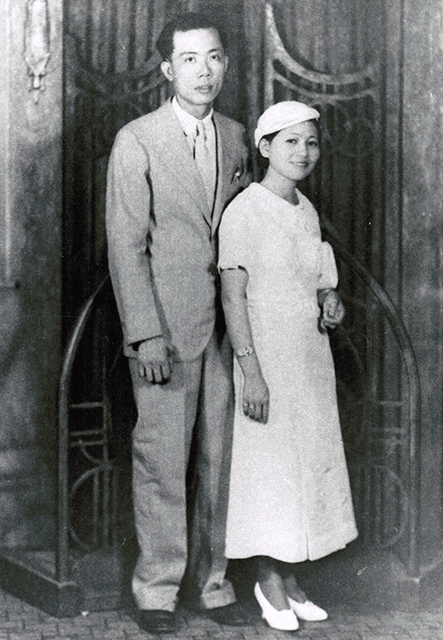 I was born in 1936, the eldest of seven children. My parents Chuck Kun Hong
and Mamie Wy Hong (shown to the left) married in Greenville, Mississippi
in 1935. My
great-grandfather, Wong Chuck Tai (from Kwangtung Province) helped build
railroads in the U.S. and was one of the earliest Chinese settlers in the state.
He and his partner Wong Foo owned a general store in Gunnison, Mississippi by 1906.
Wong Chuck Tai and his wife moved back to China in 1918. My father Chuck Kun Hong
moved from there to Cuba before settling in the United States.
I was born in 1936, the eldest of seven children. My parents Chuck Kun Hong
and Mamie Wy Hong (shown to the left) married in Greenville, Mississippi
in 1935. My
great-grandfather, Wong Chuck Tai (from Kwangtung Province) helped build
railroads in the U.S. and was one of the earliest Chinese settlers in the state.
He and his partner Wong Foo owned a general store in Gunnison, Mississippi by 1906.
Wong Chuck Tai and his wife moved back to China in 1918. My father Chuck Kun Hong
moved from there to Cuba before settling in the United States.
Through my mother's line my siblings and I are fourth generation Americans, but two of my siblings and I attended a segregated one-room school for Chinese-American children until I was in sixth grade. Until I grew up and became a teacher, I didn't know that my grand aunt, Kate Lum (Wong Tai's daughter) and her husband Gong Lum unsuccessfully challenged the exclusion of Chinese children from white schools, leading to the 1927 Supreme Court decision Lum v. Rice. That decision upheld the segregation principle of "separate but equal" established in 1896 and not struck down until 1954.
After Lum v. Rice the Lums moved across the Mississippi River to Elaine, Arkansas, where their children could attend white schools. My mother and her three siblings went to China to stay with Wong Tai's family to learn Chinese. On their return to the U.S., my mother lived in Arkansas with the Lums so she could attend school herself.
I grew up in a three-room house attached to my parents' rented corner grocery
store in Greenville. After school, the eldest three children attended Chinese
language classes from 4 to 7 P.M. Monday–Friday and on Saturday morning.
The store was open from 7 A.M. to 10 P.M. All of us cashiered, stocked shelves,
and learned to cater to customers.
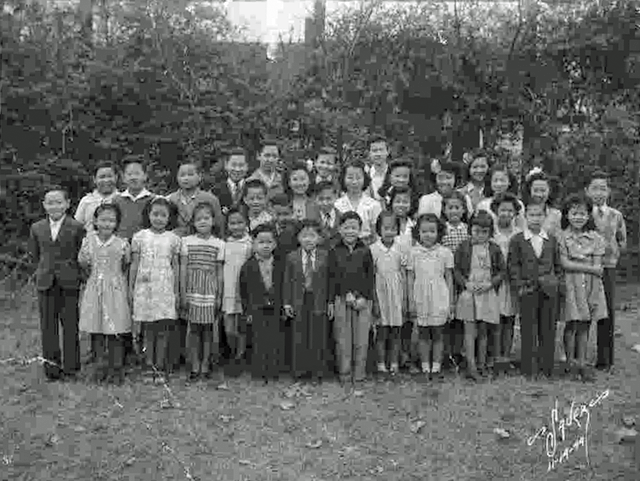
A group photo from the segregated grade school for
Chinese-Americans, in Greenville, Mississippi.
After World War II, Chinese-Americans began to attend the white schools in Greenville. After completing sixth grade I skipped seventh grade and got through junior high in two years. In 1953 I graduated with honors from E. E. Bass Junior-Senior High School. In 1958 I graduated from Mississippi State College for Women but was not allowed to obtain a teaching license.
In 1958 I married Tony Chan, who had graduated from high school in Ruleville, Mississippi. While Tony was in his last year at the Illinois College of Optometry, I taught in the Chicago Public Schools. Following his graduation in 1959, Tony passed the boards for a New Mexico license—the first Chinese-American to do so. In August of that year, we drove west on Route 66. Emerging from Tijeras Canyon into Albuquerque, in our green and yellow 1955 Buick Special, we felt like pioneers entering a promised land. We had only $400, plus a loan of $2,000 from my dad to start a practice.
Tony and I had no friends in New Mexico, so we spent our first night in Albuquerque at the Casa Grande Lodge. The next morning, when we went into the restaurant for breakfast, we were shocked to see Willie Bow and Sue Mae Joe, friends from Arkansas. They had just wed and were moving to California. Willie and Sue Mae were having dinner that evening with relatives of his, the Billy Gee family, and called them to ask if they could bring us along. Thus began our introduction to Albuquerque's Chinese-American community.
Soon we had an apartment on Domingo Road NE. The rent was $90 a month, so I scurried to apply for a teaching position. Albuquerque was growing and I was given a provisional elementary teaching certificate and hired at $4,500 per year. I must have been among the first Chinese-American teachers hired by Albuquerque Public Schools. Tony got a job as an associate of Dr. Roy F. Menning (at 128 Monroe NE), working for $350 a month. They became partners for 17 years and expanded the business to a second location (at 4401 Fourth St. NW).
I taught at Old Town Elementary (now Reginald Chavez Elementary) and La Luz Elementary schools, in mostly Hispanic neighborhoods. There I fostered multi-cultural understanding by integrating knowledge of the Chinese-American, New Mexican Hispanic, and dominant "Anglo" cultures.
At the birth of our son I left the public school system, but remained an active
supporter of education and a volunteer tutor. I was a judge for the Bernalillo
County Science Fair and also served as the vice-chair of the Mayor's Commission
on Adult Literacy. From 1981 to 1984 I served on the National Advisory Council
on Bilingual Education, after being nominated to the position by U.S. Senator
Jack Schmitt. As chair of that council for 1982–1983 I directed
preparation of the council's annual report to Secretary of Education Terrell
Bell. I was honored to represent the council at the White House presentation of
Secretary Bell's report "A Nation At Risk" to President Reagan.
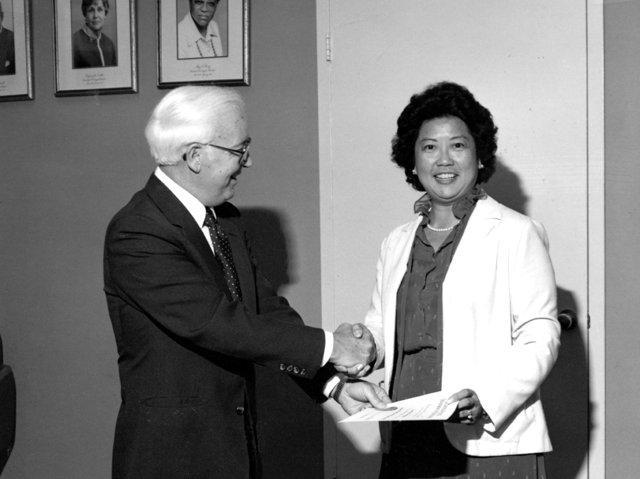
Ms. Chan with Secretary of Education Terrell Bell, at the time of her
appointment as chair
of the National Advisory Council on Bilingual Education.
For more than forty years, Tony and I have worked to support optometry and health care in general. We have served in a variety of volunteer positions and played a part in getting optometry included in Medicare Part B. In 1981 Tony (the only Asian-American to serve as a Trustee of the American Optometric Association) and I (a past president of the AOA Auxiliary) joined one of optometry's earliest People to People goodwill missions to medical schools and hospitals in China and in Japan.
We have also worked to support the Chinese-American community. In 1961 we were founding members of the Albuquerque Lodge of the Chinese American Citizens Alliance (C.A.C.A.), which for more than 100 years has protected Chinese-American civil rights, has sponsored social activities, and has supported education and youth leadership. From 1989 to 1990 I was president of the Albuquerque Lodge and directed the Chinese Moon Festival during Albuquerque's Summerfest. I have served as a C.A.C.A. national board member since 1993, and from 2009 to 2013 I was the organization's national president. I was also the C.A.C.A.'s representative for the 1882 Project, a national collaborative effort that achieved unanimous passage of U.S. House and Senate resolutions apologizing for the Chinese Exclusion Act (1882) and other anti-Chinese laws.
From 1980 to 1982 I was president of the Albuquerque Chinese School, a nonprofit organization that teaches Chinese language and culture. I also became involved in the New Mexico Museum of Natural History and Science. I served eight years on the board of the NMMNH Foundation and became board president in 1995.
On May 9, 2014 the U.S. Department of Labor inducted the Chinese railroad workers into its Hall of Honor, recognizing their role in building the nation's first transcontinental railroad. My son Rusty and I were proud to be among those workers' descendants at the impressive ceremony. All my life I have been inspired by the courage and sacrifice of my resilient forebears, the Chinese family values and work ethnic instilled by my parents, the moral support of my loving husband and children, and the opportunity to be a dedicated American. I hope this legacy will be a firm foundation for the future contributions of my grandchildren.
Tony and Carolyn are the proud parents of Tony Russell (Rusty) Chan and Dr. Mamie
C. Chan and the grandparents of Sabina and Maximo Cottrill, whose father Gordon
is a mechanical engineer. Public service is a hallmark of the family. Son Rusty
Chan has been president of the C.A.C.A.'s Albuquerque Lodge for seven years,
national secretary for four years, and currently also serves as national
Vice-President of Communications. Daughter Mamie performed traditional dances as
a youth at the Chinese Moon Festival. She teaches traditional Chinese dances to
young girls, including her seven-year-old daughter, to perform at Chinese New Year
celebrations and at the Festival of Asian Cultures. Dr. Mamie, like her father, is
a past president of the New Mexico Optometric Association and of the Illinois
College of Optometry Alumni Council.
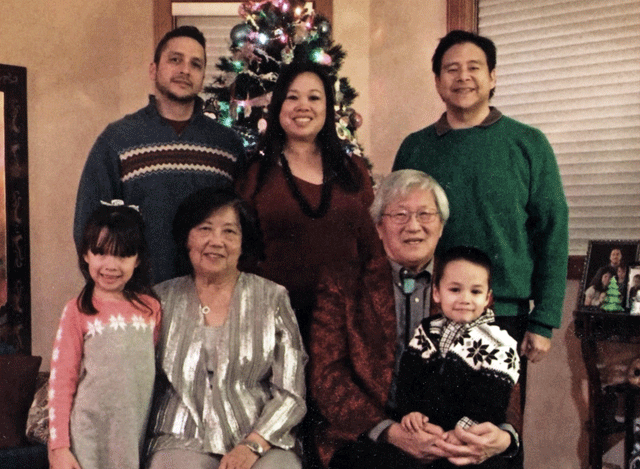
The Chan Family's 2014 Christmas picture
For a second view of the Chan Family's wood and porcelain tray, and to see an additional ceramic item in the family's collection, please click here.
See source code for photo credits and copyright information. Page last revised on November 13, 2015. Please report problems to toh@unm.edu